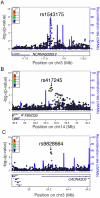Genome-wide local ancestry approach identifies genes and variants associated with chemotherapeutic susceptibility in African Americans
- PMID: 21755009
- PMCID: PMC3130766
- DOI: 10.1371/journal.pone.0021920
Genome-wide local ancestry approach identifies genes and variants associated with chemotherapeutic susceptibility in African Americans
Abstract
Chemotherapeutic agents are used in the treatment of many cancers, yet variable resistance and toxicities among individuals limit successful outcomes. Several studies have indicated outcome differences associated with ancestry among patients with various cancer types. Using both traditional SNP-based and newly developed gene-based genome-wide approaches, we investigated the genetics of chemotherapeutic susceptibility in lymphoblastoid cell lines derived from 83 African Americans, a population for which there is a disparity in the number of genome-wide studies performed. To account for population structure in this admixed population, we incorporated local ancestry information into our association model. We tested over 2 million SNPs and identified 325, 176, 240, and 190 SNPs that were suggestively associated with cytarabine-, 5'-deoxyfluorouridine (5'-DFUR)-, carboplatin-, and cisplatin-induced cytotoxicity, respectively (p≤10(-4)). Importantly, some of these variants are found only in populations of African descent. We also show that cisplatin-susceptibility SNPs are enriched for carboplatin-susceptibility SNPs. Using a gene-based genome-wide association approach, we identified 26, 11, 20, and 41 suggestive candidate genes for association with cytarabine-, 5'-DFUR-, carboplatin-, and cisplatin-induced cytotoxicity, respectively (p≤10(-3)). Fourteen of these genes showed evidence of association with their respective chemotherapeutic phenotypes in the Yoruba from Ibadan, Nigeria (p<0.05), including TP53I11, COPS5 and GAS8, which are known to be involved in tumorigenesis. Although our results require further study, we have identified variants and genes associated with chemotherapeutic susceptibility in African Americans by using an approach that incorporates local ancestry information.
Conflict of interest statement
Figures






Similar articles
-
Impact of ancestry and common genetic variants on QT interval in African Americans.Circ Cardiovasc Genet. 2012 Dec;5(6):647-55. doi: 10.1161/CIRCGENETICS.112.962787. Epub 2012 Nov 19. Circ Cardiovasc Genet. 2012. PMID: 23166209 Free PMC article.
-
Chemotherapeutic-induced apoptosis: a phenotype for pharmacogenomics studies.Pharmacogenet Genomics. 2011 Aug;21(8):476-88. doi: 10.1097/FPC.0b013e3283481967. Pharmacogenet Genomics. 2011. PMID: 21642893 Free PMC article.
-
Genome-wide meta-analysis identifies variants associated with platinating agent susceptibility across populations.Pharmacogenomics J. 2013 Feb;13(1):35-43. doi: 10.1038/tpj.2011.38. Epub 2011 Aug 16. Pharmacogenomics J. 2013. PMID: 21844884 Free PMC article.
-
Population differences in platinum toxicity as a means to identify novel genetic susceptibility variants.Pharmacogenet Genomics. 2010 May;20(5):327-37. doi: 10.1097/FPC.0b013e3283396c4e. Pharmacogenet Genomics. 2010. PMID: 20393316 Free PMC article.
-
Integration of genetic and functional genomics data to uncover chemotherapeutic induced cytotoxicity.Pharmacogenomics J. 2019 Apr;19(2):178-190. doi: 10.1038/s41397-018-0024-6. Epub 2018 May 25. Pharmacogenomics J. 2019. PMID: 29795408
Cited by
-
Using germline genomics to individualize pediatric cancer treatments.Clin Cancer Res. 2012 May 15;18(10):2791-800. doi: 10.1158/1078-0432.CCR-11-1938. Clin Cancer Res. 2012. PMID: 22589487 Free PMC article. Review.
-
Relating human genetic variation to variation in drug responses.Trends Genet. 2012 Oct;28(10):487-95. doi: 10.1016/j.tig.2012.06.008. Epub 2012 Jul 26. Trends Genet. 2012. PMID: 22840197 Free PMC article. Review.
-
Integration of cell line and clinical trial genome-wide analyses supports a polygenic architecture of Paclitaxel-induced sensory peripheral neuropathy.Clin Cancer Res. 2013 Jan 15;19(2):491-9. doi: 10.1158/1078-0432.CCR-12-2618. Epub 2012 Nov 30. Clin Cancer Res. 2013. PMID: 23204130 Free PMC article.
-
Trans-population analysis of genetic mechanisms of ethnic disparities in neuroblastoma survival.J Natl Cancer Inst. 2013 Feb 20;105(4):302-9. doi: 10.1093/jnci/djs503. Epub 2012 Dec 14. J Natl Cancer Inst. 2013. PMID: 23243203 Free PMC article.
-
The long noncoding RNA GAS8-AS1 suppresses hepatocarcinogenesis by epigenetically activating the tumor suppressor GAS8.J Biol Chem. 2018 Nov 2;293(44):17154-17165. doi: 10.1074/jbc.RA118.003055. Epub 2018 Sep 18. J Biol Chem. 2018. PMID: 30228180 Free PMC article.
References
Publication types
MeSH terms
Substances
Grants and funding
LinkOut - more resources
Full Text Sources
Medical
Research Materials

